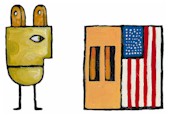
Video has a number of inherent or structural advantages over the existing news media for the communication of political discourse. But viable real-world business enterprises require more than structural advantages. Somebody needs to find a practical way to exploit this potential. What could generate a "critical mass" of public interest in using video to evaluate candidates?
One way would be to combine stump speeches from all of a political party’s candidates in a primary into a single cassette.
For example, if six candidates were in a primary, and each was given 20 minutes of tape time, the total would come to 2 hours—the standard length for a rental videocassette. A tape counter index could also be added, serving essentially the same function as page numbers in a magazine’s table of contents. If a viewer was convinced that Candidate A didn’t offer much that interested him, he could fast-forward directly to Candidate B.
With this type of selection capability factored in, total viewing time for most people would probably be less than an hour. That’s a length of time that many people could be interested in, for something that they’d never seen before.
Certainly it would have more than one advantage over today’s televised candidate "debates." We would see full fields of candidates for their parties’ nominations, rather than just the ones who survived to the end of the process. We also wouldn’t be forced to settle for only what political reporters choose to ask about.
While not all that many of us might be likely to pop this sort of cassette into the VCR on a Saturday night for pure entertainment, a lot of us could probably find a weeknight when the idea would be intriguing.
And if voters might regard the idea of a "video stump" as even slightly interesting, people running for public office ought to find it downright fascinating.
Today’s politicians spend fortunes, incurring enormous and debilitating political debts in the process, trying to put their "messages" across in paid political advertising, where the format is so slick and quick that it’s difficult to imagine anyone feeling they’ve heard enough to make a reasonable evaluation. A "video stump" could break this dependence on big donors to buy media time.
Simple videotaped segments of the candidates, delivering their standard stump speeches to real-life audiences in real-life settings, could have the authenticity and substance that voters crave. They could also be produced at very little cost—certainly for far less than the typical 30-second television commercial. One or two moonlighting camera crews from a local television news operation could shoot the whole affair in a couple of weekends. Final editing could require so little time as to be almost not a factor.
The job of assembling and distributing such a compilation ought to be undertaken by somebody other than the candidates themselves. The party for whose nomination the candidates were competing could perform this function. But probably a better choice would be an independent organization like the League of Women Voters.
Better still, though, might be a for-profit business venture. This could keep the video from being perceived by viewers as "good for them" (i.e, boring). Also, if the video product owed its existence to nothing more than the economics of market demand, it would be resistant to attempts to mold, shape, or otherwise manipulate it.
Ultimately, though, the issue of whether such a product should debut in a for-profit or nonprofit mode is of far less importance than just getting it out there on the shelves of Blockbuster and Hollywood Video, in one way or another.
Restoring voters’ access to stump speeches would benefit us all. It would enable candidates to speak directly to the people, without the increasingly unhelpful and sometimes outright suspect intervention of news organizations. As part of this process, it would reduce candidates’ dependence on advertising. And by so doing, it would create an environment where a candidate with good ideas—as opposed to merely having a large media budget—could make a powerful impression.
Isn’t this what we really want our electoral process to be about?


